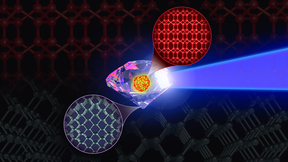Vital NIF diagnostic receives upgrade
 (Download Image)
The upgraded Near Backscatter Imager installed in the NIF Target Chamber.
(Download Image)
The upgraded Near Backscatter Imager installed in the NIF Target Chamber.
When the National Ignition Facility’s 192 intense laser beams are fired, a series of complex events begins. To capture and measure the vast amount of data generated during experiments, NIF is now equipped with about 60 nuclear, optical and X-ray diagnostics. One of these diagnostics, the Near Backscatter Imager (NBI), recently received an upgrade.
Developed in the mid-2000s, the NBI is run during nearly every kind of experiment conducted at NIF and measures backscatter, the result of the interaction between incident laser light and plasma waves at a target.
Plasmas are composed on free ions and free electrons. Both the ions and electrons can have high amplitude waves. When the laser interacts with ion waves, the resultant scattered light is called Stimulated Brilluoin Backscattering (SBS). This backscattered light is close to the incident light wavelength and returns back into the beamlines, where, if not controlled, it can reach powers and energies sufficient to damage optics in the NIF laser system.
Electrons produce high frequency waves in a plasma. Light scatter from the electron plasma waves is called Stimulated Raman Backscattering (SRS), a type of laser-plasma instability. In SRS, electron density fluctuations in the plasma cause the incident laser light to scatter resonantly. High levels of backscatter reduce the coupling of laser energy to the fusion target and constrain implosion symmetry and other design parameters.
NBI provides the most accurate total SBS and SRS backscattered energy measurements on the NIF. The diagnostic does this by measuring the light backscattered outside the NIF beamlines onto diffuse Spectralon™ scatter plates surrounding the quad. Precisely calibrated images of the backscattered light on the scatter plates are used to determine the time-integrated spatial distribution and total energy of SBS and SRS independently. Additionally, fibers are used to create power time histories and spectra of the backscattered light.
NBI scatter plates have been installed on NIF since 2009 and have degraded over time. During a planned upgrade, the two original scatter plates were replaced. In addition, two new devices were installed, allowing the backscatter to be measured on all four NIF beam cone angles once the imaging system upgrade is installed next summer. This system will provide a more complete picture of the backscatter from targets.
"The new system also was designed to be more operationally friendly – if maintenance is required it is easy to do. The new design is modular, so if there is any failure a module can be replaced quickly," said Robin Hibbard, lead NBI engineer. "From a scientific perspective, putting new hardware in allows for resetting the system calibration with the new material. It also allows inspection and measuring the old hardware and the calibration can be checked against experimental data."
In addition to Hibbard as lead engineer, other contributors to NBI include: Joe Ralph, lead scientist; Bob Chow, responsible system engineer; Mike Vitalich, mechanical designer; Jarom Nelson, calibration; and John Moody, group leader for holhraums and optical diagnostics.
Contact
 Breanna Bishop
Breanna Bishop
[email protected]
(925) 423-9802
Related Links
NIF&PSNIF Diagnostics
Tags
National Ignition Facility and Photon ScienceNational Ignition Facility
Lasers and Optical S&T
Lasers
Science
Featured Articles







